We test and review fitness products based on an independent, multi-point methodology. If you use our links to purchase something, we may earn a commission. Read our disclosures.
Arnold Schwarzenegger left an indelible mark on the bodybuilding world. During his competition career, he stacked a staggering five Mr. Universe and seven Mr. Olympia titles.
So, it’s no surprise that fitness-focused folks today still look to the Terminator for tips, tricks, and techniques that may help them taste even an ounce of Arnie’s success. You’ve got to train like the best if you want to be the best, correct?
RELATED: Arnold’s Arm Workout
Kate Meier, NASM-CPT, USAW-L1, CF-L1, and GGR senior director of content, is breaking down the Austrian Oak’s signature shoulder exercise, the aptly named Arnold press, to help you build boulder shoulders.
Come with us if you want to lift!
How To Do the Arnold Press
The Arnold press has a similar movement pattern to the classic dumbbell shoulder press but incorporates rotation to activate all three heads of the deltoids. The move also features a more extensive range of motion, making it even more effective.
How to do it:
- Hold a dumbbell in each hand with your palms facing your chest.
- Press the dumbbells overhead and rotate your wrists outward as you move upward.
- Continue until you reach the lockout position. Your palms should now face away from you.
- Squeeze your deltoids, then reverse the movement with control to return to the starting position.
- Repeat for reps.
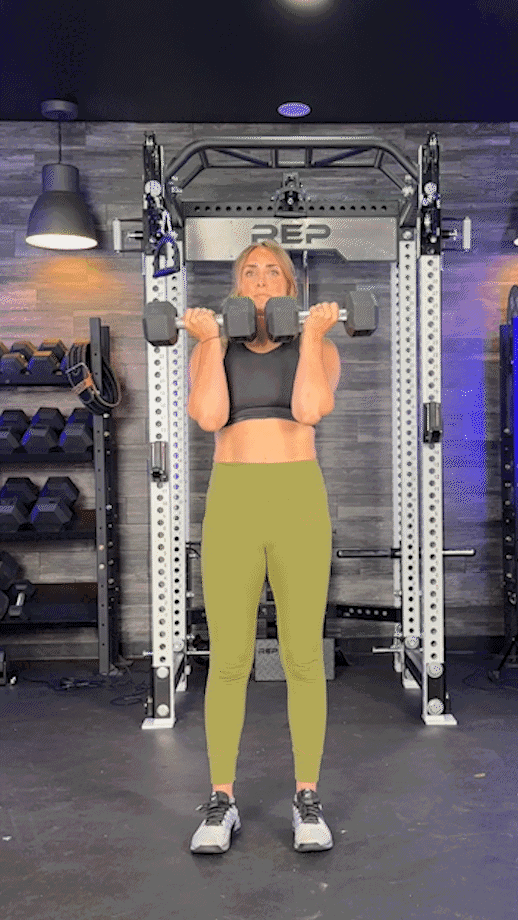
How To Do the Arnold Press At Home
Arnold trained at the world-famous Gold’s Gym in California, but you won’t need to brush elbows with the biggest bruisers in bodybuilding to enjoy similar gains. All you need is a pair of the best dumbbells, and you can get your reps in from the comfort of your home gym.
How To Program the Arnold Press
Arnold’s trademark move is one of the best exercises for your shoulders since it hits the rear, medial, and front delts in one fell swoop. Arnold used it primarily to build muscle, but you can also increase your muscular endurance with this exercise.
- For hypertrophy: 3 to 6 sets of 6 to 12 reps using moderate weights
- For endurance: 2 to 3 sets of 15 to 20 reps using light weights
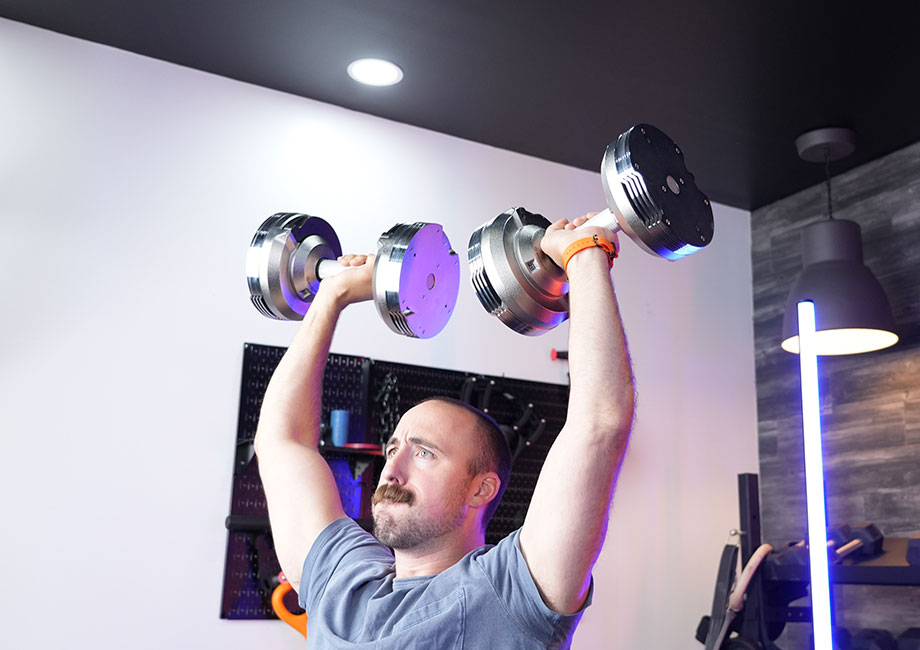
“Theoretically, you can program the Arnold press as a strength training exercise, but the results would likely pale in comparison to regular barbell overhead press exercises,” says Kate Meier, NASM-CPT, USAW-L1, CF-L1. “That includes the strict press, push press, and even the push or split jerk exercises.”
RELATED: How Many Reps To Build Muscle
Arnold Press Variations
The standing Arnold press is the standard on this exercise, but it’s not the only way you can perform it:
Seated Arnold press
Sitting down is a trade-off. The back support of a weight benches’ pad or the back of a chair stabilizes your torso, so you’re getting less core activation, but you should also be able to lift heavier.
“The seated Arnold press lets you push into the weight bench and get some extra back support, but the standing version relies almost exclusively on the core muscles to maintain good posture during the lift,” adds Kate.
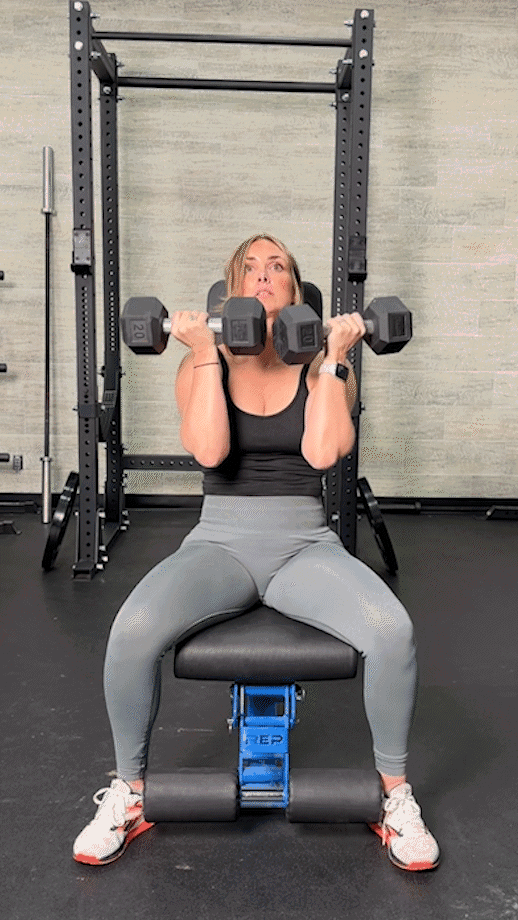
Dumbbell Push Press
While the Arnold press is more of an upper-body isolation exercise, the dumbbell push press exercise is a compound lift that uses lower-body muscles to propel the weights to the overhead position.
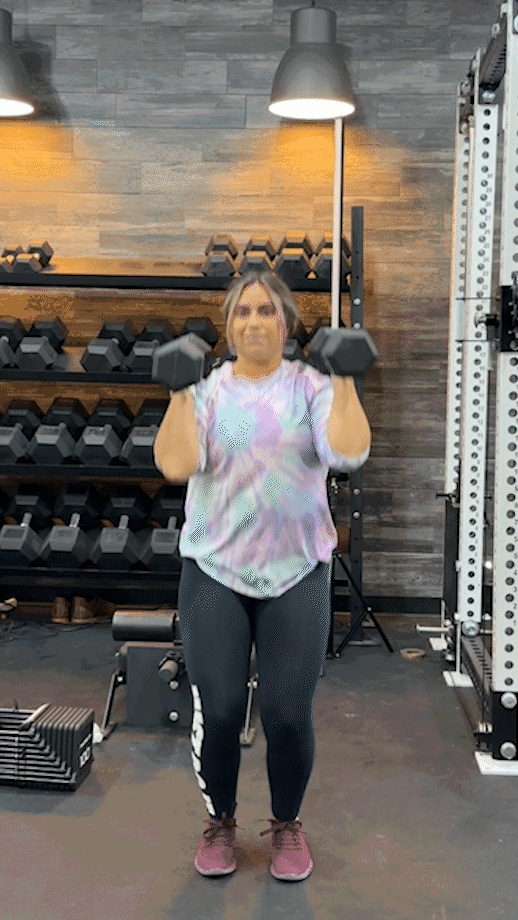
Arnold Press Alternatives
Remember—Arnold Schwarzenegger used the Arnold press as part of his strength training program to become one of the best and most famous bodybuilders, but the keywords here are “part of.”
Loads of great shoulder exercises will help you improve your overhead strength, build muscle in your shoulders, and increase your endurance. Here are our favorite Arnold press alternatives.
Seated Shoulder Press
Why do it: The seated shoulder press is one of the best shoulder exercises for upper-body development in general. How? According to the Journal of Strength and Conditioning Research1, sitting down creates a wide, stable base, allowing you to go heavier than you could if you were standing.
How to do it:
- Set up your weight bench, select your dumbbells, and sit down.
- Hold the dumbbells slightly above your shoulders with your palms facing away from you.
- Extend your elbows and engage your shoulder muscles to press the dumbbells overhead.
- Continue until you reach full lockout. Squeeze the contraction at the top of the movement.
- Slowly return to the starting position.
- Repeat for reps.
RELATED: Best Weight Benches
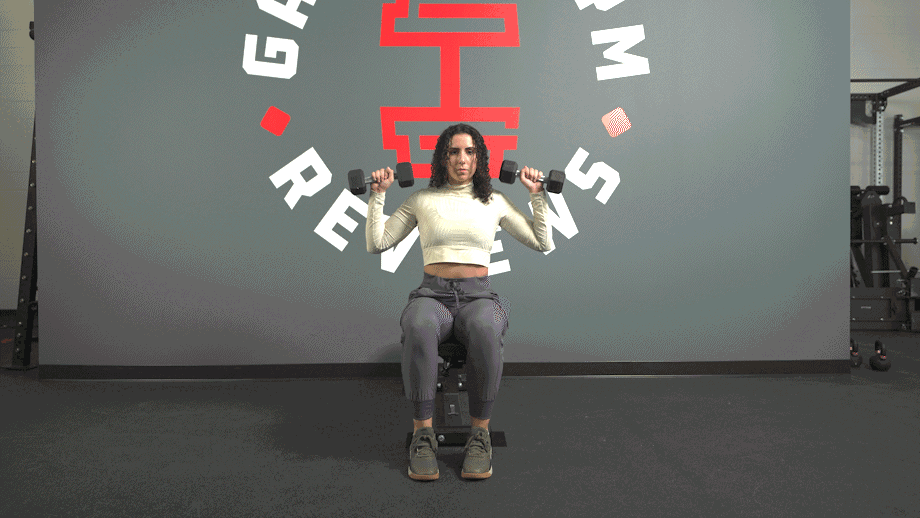
Side-to-Side Landmine Press
Why do it: “Overhead movements are tricky for some,” says Kate Meier, NASM-CPT, USAW-L1, CF-L1. “The side-to-side landmine press offers an alternative that still works the deltoids through multiple planes of motion, just like the Arnold press, but requires no overhead pressing.”
How to do it:
- Connect your barbell to a landmine attachment and load to your desired weight.
- Grip the end of the barbell with both hands and lift it to chest height.
- Lift the barbell upward and outward.
- Move the barbell to one side, keeping your core contracted.
- Return the barbell to center, then move it to the opposite side.
- Continue alternating sides until all reps are complete.
RELATED: Best Landmine Exercises
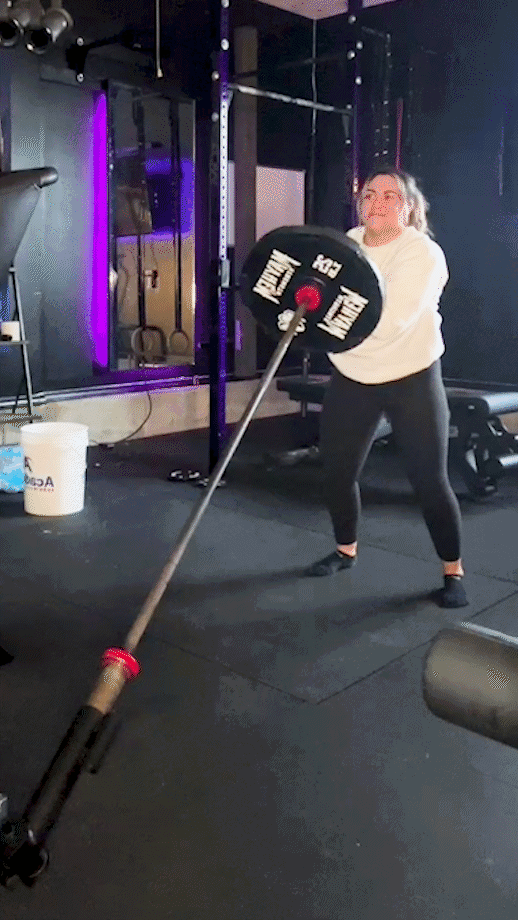
Bottoms-Up Kettlebell Press
Why do it: The bottoms-up kettlebell press adds significant instability to the lift, requiring your shoulders and other surrounding muscles to stabilize the weight. According to the Journal of Bodywork and Movement Therapies2, it also activates your serratus anterior, a muscle known to assist with overhead stability.
How to do it:
- Stand with your core fully engaged, or sit upright on a weight bench or plyo box without back support.
- Grip the handle of a kettlebell and invert it, holding it with your elbow bent.
- Slowly extend the elbow to press the kettlebell to the ceiling.
- Continue until you reach full lockout.
- Pause, then slowly return to the starting position.
- Complete all reps, then switch sides and repeat the set.
RELATED: Best Kettlebells
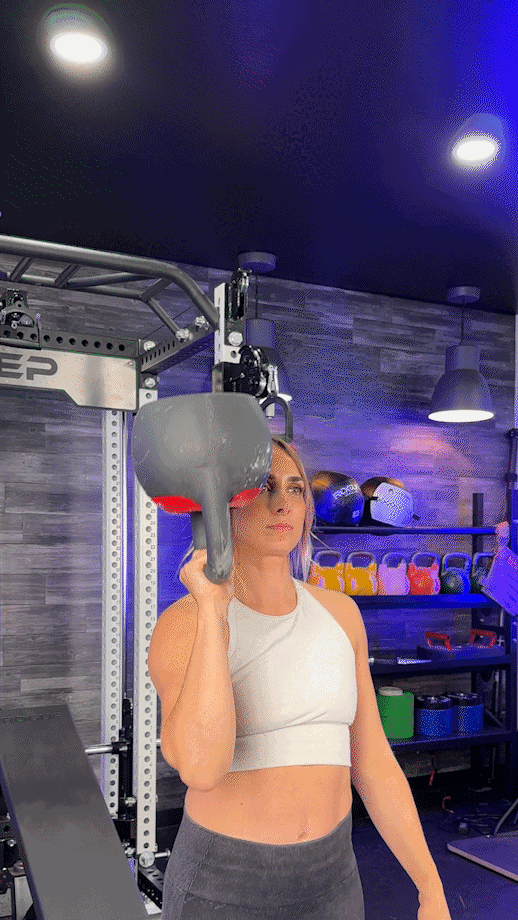
Dumbbell Clean and Press
Why do it: The dumbbell clean and press is the perfect alternative if you’re not ready to say hasta la vista to the rest of your body. This move hits most of your major muscle groups, including the glutes, hamstrings, triceps, spinal erectors, quadriceps, lower back, and (of course) the delts.
How to do it:
- Stand with your feet shoulder-width apart, chest tall, back flat, core tight, and a dumbbell in each hand held with a neutral grip.
- Push your hips back, bend your knees, and tap the floor with the dumbbells’ ends.
- Drive through your feet, extend your hips, knees, and ankles, and pull the dumbbells to your shoulders in one fluid movement.
- Press the dumbbells overhead, squeezing your delts, traps, and glutes at the top.
- Slowly return to the starting position and cycle into the next rep.
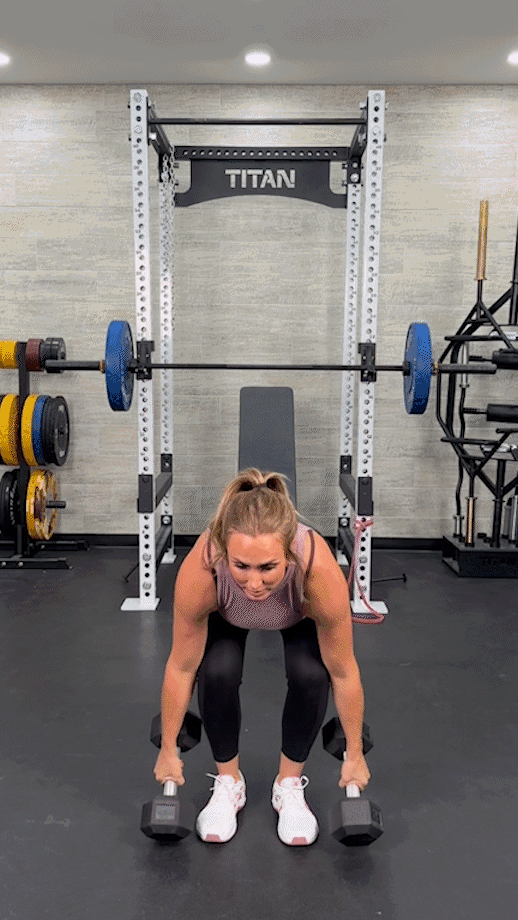
Benefits of the Arnold Press
You can garner some great gains from performing the Arnold press regularly, but some benefits are exclusive to this exercise.
Better Muscle Activation
The Arnold press is unique in that you can hit the anterior deltoid, medial deltoid, and posterior deltoid in one convenient movement, thanks to that trademark rotation. You’d have to perform multiple exercises to achieve the same effect.
So, you can achieve even growth across all heads of the deltoid and do it in less time.
RELATED: Best Deltoid Exercises
Bigger Range of Motion
“Because your palms are facing you in the starting position, your hands begin lower than they would be in the starting position of the standard dumbbell shoulder press,” says Kate Meier, NASM-CPT, USAW-L1, CF-L1.

“So the Arnold press features a larger range of motion, maximizing your time under tension, targeting more muscles, and allowing for a better workout while using comparatively lighter weights.”
Mobility and Coordination
While many overhead press variations involve a simple elbow extension to press the weights overhead, the Arnold press adds rotation to make for an overall more complex movement.
Couple this with the fuller range of motion, and you’ve got yourself an exercise that tests and enhances your shoulder mobility and coordination on each rep.
Arnie used his famous pressing exercise for hypertrophy, but the mobility benefits associated with it make it a great warm-up and/or finisher exercise, too.
RELATED: Best Mobility Exercises
Common Arnold Press Mistakes
As long as you totally recall all our tips, you should learn the proper form for the Arnold press with practice and dedication. But you’ll still want to watch out for some of the most common Arnold press mistakes and terminate them.
Rotating Too Far
Rotation is the defining characteristic of the Arnold press, but too much of a good thing—in this case—can produce an adverse effect.
“The Arnold press involves internally rotating the shoulders as you press weights upward, which may close the space between the humerus bone in your upper arm and clavicle,” says Kate. “To avoid this, rotate gradually and wait to complete the rotation until you reach full lockout. This allows you to enjoy the full benefits of the Arnold press while reducing your risk of injury.”
Further, the proper positioning for the Arnold press involves keeping the elbows tucked into the body, stacked directly beneath the wrists, for optimal stability. If you can’t maintain that picturesque vertically aligned positioning, consider using lighter weights until you can. It doesn’t matter if you’re doing the Arnold press, military press, or any variation of the overhead press; don’t allow your elbows to flare out as you press the weights overhead.
“Flared elbows reduce muscle activation in the upper body, namely the triceps and upper pecs,” says Kate. “More importantly, it may place stress on the shoulder joint and lead to an injury.”
Going Too Heavy
Biting off more than you could chew is a cardinal sin in the gym. It’s especially unhelpful with the Arnold press because using more weight than you can handle can inhibit and potentially impede your ability to rotate your forearms, ultimately providing less muscle activation to the deltoids and other target muscle groups.
Instead, stick with a weight that allows you to complete most of your reps comfortably. You should be able to get a good rotation and work at a consistent tempo with minimal to no sticking points. Only the last one or two reps should be hard-earned.
Pressing Too Far Forward
It doesn’t matter if you’re doing the Arnold, overhead, or bench press; the ideal bar path is straight up and down with your wrists and elbows vertically stacked.
“The Arnold press starts with your hands at shoulder level and your palms facing your face, but that doesn’t mean you should arc outward as you press the dumbbells up,” says Kate. “Doing so is inefficient and will place stress on your shoulder joint.”

So, even though it may feel weird and uncomfortable at first, still do your best to maintain a straight bar path while keeping your wrists stacked over your elbows. Your body thanks you in advance.
Moving Too Quickly
Standard shoulder presses predominantly target the anterior and medial deltoids, leaving the poor posterior deltoids in the dust. The Arnold press solves this issue by rotating, letting your rear delts get the same love and attention as the rest of your shoulder muscles.
“Rushing through your reps tends to diminish that effect,” says Kate. “First of all, you wind up spending less time under tension, but you also may inadvertently use momentum to effectively do the work for you, ultimately defeating the purpose of the Arnold press.”
Instead, take your time during the eccentric and concentric phases of the Arnold press. It’s the best way to get the most activation in your shoulder muscles and reap the most reward.
RELATED: A Comprehensive Guide to Eccentric Training
Forgetting to Brace Your Core
We can’t overstate the importance of bracing your core. That goes for the Arnold press and virtually all weightlifting exercises, as a tight core, lets you maximize your ability to produce power while minimizing the risk of injury to your spine.
To remind yourself to brace, take a deep breath in the starting position, exhale and tighten as you press the weights overhead, breathe in again as you bring them back down, lather, rinse, and repeat.
Supplementing your shoulder workout with some functional core exercises can’t hurt either.
Muscles Worked by the Arnold Press
One of the major benefits of the Arnold press is the sheer magnitude of muscles worked, including your:

- Deltoids: The deltoid muscles, consisting of three heads, give your shoulders a rounded appearance. You also activate all three heads of the deltoid during the Arnold press.
- Triceps: The major muscle on the backside of your upper arm, your triceps control elbow extension, meaning they’re imperative to performing the Arnold press movement.
- Upper body: The delts and triceps run the show, but upper-body muscles like the pecs, serratus anterior, and trapezius muscles all contribute to the movement to some degree.
- Core: Your core helps stabilize your torso as you press weight, so you can produce more power and reduce your risk of injury to your lower back or spine.
Arnold Press: Final Thoughts
No matter how you feel about Arnold Schwarzenegger, there’s no denying that he knew what he was doing when it came to bodybuilding. And he owed that legendary, record-setting physique—in part—to his signature shoulder exercise: the Arnold press.
You, too, can rake in the gains by adding the Arnold press to your shoulder workouts. Perhaps you won’t enjoy the same level of success as The Governator, but building bigger delts with this top-tier movement is still worthwhile.
RELATED: Shoulder Workouts with Dumbbells
So, the next time you’ll be back in the gym, give the Arnold press a try!
Arnold Press: FAQs
What does Arnold press work?
The Arnold press primarily works the deltoid muscles, activating all three heads of this important shoulder muscle. The triceps also enjoy a fair amount of activation, while tertiary muscles include the pecs, traps, and core.
Does Arnold press hit all heads?
“Most shoulder exercises emphasize the front and medial heads of the deltoid, but the Arnold press uses rotation to rope in the rear delts, too,” says Kate Meier, NASM-CPT, USAW-L1, CF-L1, and GGR senior director of content. “It’s one of very few exercises, if not the only exercise, that effectively targets all three heads of the deltoid at once.”
RELATED: Best Rear Delt Exercises
What is a good Arnold press weight?
When determining a good weight for your Arnold press, consider your dumbbell shoulder press working weights and one-rep max and use it as a baseline.
It’s important to note that while these exercises are similar, most lifters are stronger on the standard shoulder press than they are on the Arnold press. So, aim to do less when doing Arnolds versus regular shoulder presses.
“Most importantly, listen to your body,” recommends Kate. “Your form will deteriorate, or you’ll be unable to complete the movement fluidly if you’ve gone too heavy. Work within your abilities, do your reps using proper form, keep consistent, and you’ll see results soon!”
So, until next time, fitness fam. Hasta la vista, baby!
References
1. Saeterbakken AH, Fimland MS. Effects of body position and loading modality on muscle activity and strength in shoulder presses. J Strength Cond Res. 2013;27(7):1824-1831. doi:10.1519/JSC.0b013e318276b873
2. Busch A, Sarver X, Comstock K. Electromyographic analysis of shoulder-complex muscles performing overhead presses with dumbbell, kettlebell, and bottom-up kettlebell. J Bodyw Mov Ther. 2024;37:308-314. doi:10.1016/j.jbmt.2023.10.001
Further reading

In GGR's DripDrop ORS Hydration Solution Review, nutrition experts reveal whether this doctor-formulated electrolyte powder suits your hydration needs. Read more

How does an Olympic plate loadable weighted vest compare to traditional weighted vests? Find out in our Kensui EZ-Vest Weighted Vest review. Read more

The GymNext Flex Timeris a gym timer controlled by your phone via Bluetooth. We found that we preferred using our phone instead of the remote we often lost and liked the ease of programming via the app. If you're wanting a gym timer for your Garage Gym or Commercial Gym, this is a great option. Read more

We asked a fitness expert to detail reps vs sets, including the different types of reps and sets, and how many of each you should do for your training goals. Read more

